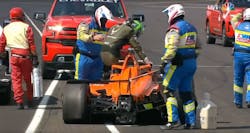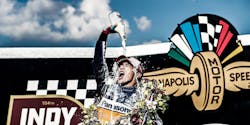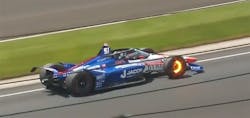Aeroscreen Proves Its Worth at Indy 500
This blog entry appeared in Electronic Design and has been published here with permission.
This year’s Indianapolis 500 started with 33 drivers, but a few did not finish the 500-mile, 200-lap race due to accidents. Thankfully all of the drivers are okay, and many of these spectacular accidents underscored the importance of the new Aeroscreen now used by every car. We have covered this advance in "Indy Cars Get a Little Safer—Thanks to a 200+ mph Windshield" and "DragonSpeed Safety on Display at Sebring."
The ultimate winner of this year’s race was Takuma Sato (Fig. 1). Sato is a two-time winner at the Indianapolis 500. He beat out Scott Dixon, who led for much of the race, but his final pit stop was slower than Sato’s. On top of that, the competition came to a close under a yellow flag due to Spencer Pigot’s crash just a few laps before the end of the race. Sato drove for Rahal Letterman Lanigan Racing. It turns out that this team is owned by late night TV icon David Letterman along with Indy car veteran Bobby Rahal and Mike Lanigan.
Lap 1 might have been the harbinger of what was to come. Ed Carpenter’s car was damaged after a close call with Zach Veach. Carpenter got to pit row and his team was eventually able to get the car back into working order, allowing him to finish 26th out of the field of 33. Nonetheless, his car was one of the intact vehicles at the end of the race.
James Davison had to contend with an exploding brake rotor in lap 5 (Fig. 2). The wheels are made of magnesium, which is both light and combustible, but magnesium alloy wheels will not usually burn on their own. Unfortunately, something caused a lot of heat and eventually the frame broke and tire burned. Fortunately, though, Davison was able to stop the car and safety crews were able to take care of the situation. They were going to have a busy day.
Marcus Ericsson’s car clipped the outer wall on turn 1 of lap 25. Dalton Kellett had a similar problem in turn 3 of lap 84, cutting the field to 30 cars.
It was not until lap 93 that another crash occurred involving Conor Daly and Oliver Askew (see video below). The crash started as Conor Daly hit the concrete rumble strips in turn 4 and then spun off, kicking up a cloud. Oliver Askew was following closely and tried to avoid Daly but also spun out, hitting barriers.
Lap 93 was the scene for two related crashes involving Conor Daly and Oliver Askew.
In lap 122, Alex Palou hit the wall in turn 1.
The final crash occurred in lap 145 near the end of the race. Alexander Rossi, who was forced to start near the end of the field due to a controversial pit road penalty with Takuma Sato, slid into the wall on turn 2. This brought out the yellow flag that the competition finished under.
As bashed and battered as many of the cars were after their crashes, the occupants were intact due to a combination of safety features of the cars and the track. This includes the Aeroscreen now mandated for all cars as well as the Suspension Wheel/Wing Energy Management System (SWEMS), whose cables prevented large debris from flying away from the cars. The Steel and Foam Energy Reduction Barriers (SAFER Barrier) that dot the track played a significant part in slowing the cars.
Hydraulics & Pneumatics' sister publications Electronic Design and Machine Design were part of the sponsors for the DragonSpeed car at the Indy 500. DragonSpeed’s Ben Hanley, driving car 81 (Fig. 3), moved up from the 33rd position to finish 23rd. This is only the second time DragonSpeed has participated in the Indianapolis 500. Earlier, the DragonSpeed team, including drivers Henrik Hedman and Ben Hanley, came in first in the LMP2 category at the IMSA Road America competition.
This year’s Indy 500 was exciting even without fans in the stands. There were some disappointments due to the crashes, but the safety features of the cars and track as well as the determination of the drivers kept the competition from being a mournful one.
About the Author

Leaders relevant to this article:



